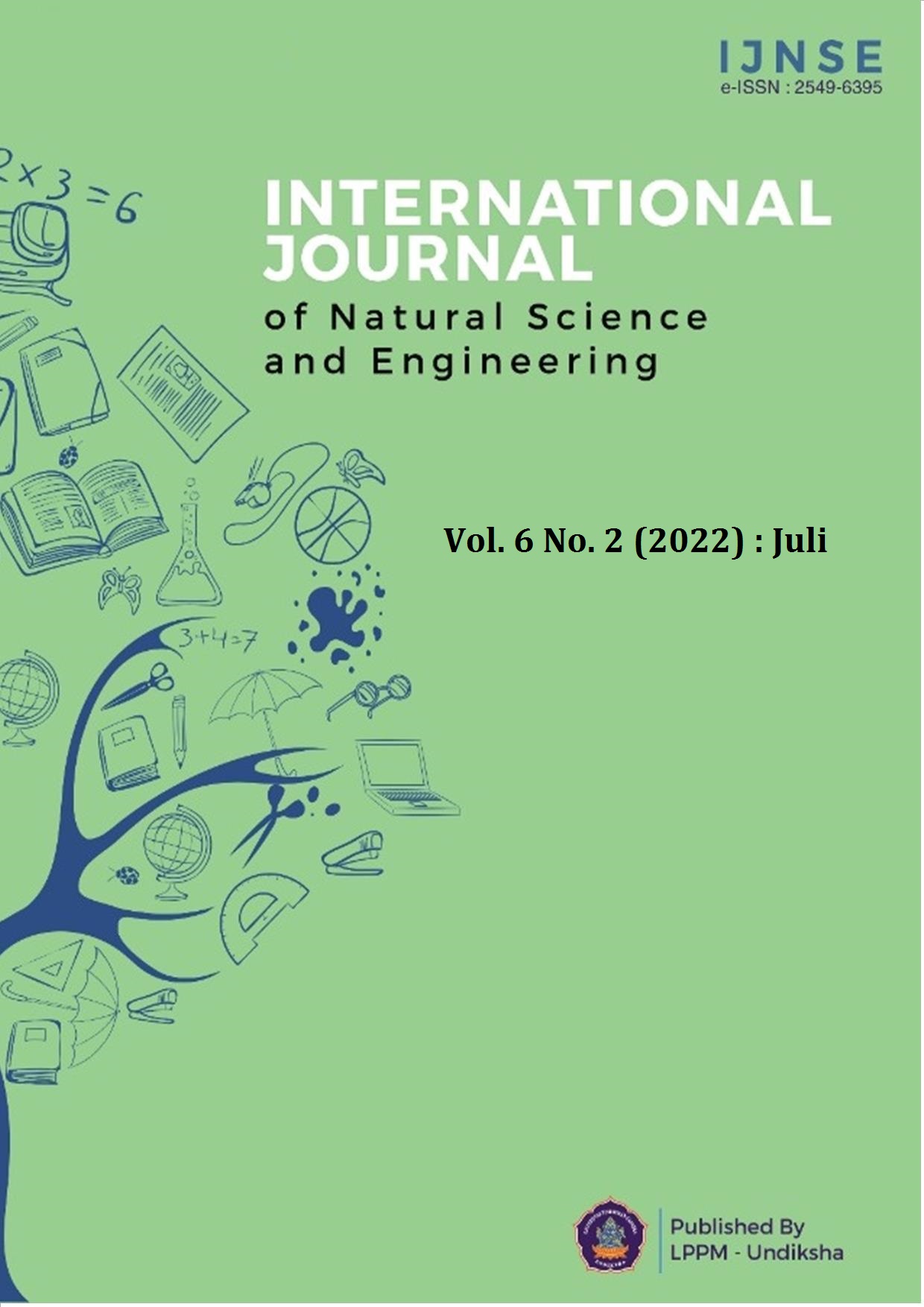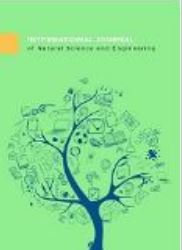Identification of Land Fire Risk Areas with Random Forest Using Landsat Image Data 8 OLI
DOI:
https://doi.org/10.23887/ijnse.v6i2.48686Keywords:
Identifikasi, Citra Landsat 8 OLI, Random ForestAbstract
Land fire is a complex and serious problem affecting several human life sectors. Stimulating the occurrence of land fires caused by long dry seasons and erratic rainy seasons causes plants to dry up and die. Illegal land burning by irresponsible people for expansion and other interests. This study uses quantitative methods. The variables used are vegetation index values obtained from Landsat 8 OLI images. The result of this research is that data classified using the random forest algorithm at RStudio produces a default number of 500 trees, and the number of variables tested in each split is 2. So, the estimated error rate of 2 out of the bag is 0.47%. Prediction and confusion matrix - train 403 data are less risky "0" (middle risk) of a fire, and there are 22 data of high risk of "1" (high risk) of a fire, with an accuracy value of 0.9914, 1. While the second prediction of the confusion matrix - test data, there are 167 data less risky "0" (middle risk) of fire. There is 1 data with a high risk of “1” (high risk) of a fire. There are seven high-risk data "1" (high risk) of fire, with an accuracy value of 0.9943, indicating a more accurate assessment of model accuracy, and the range is still good, around 96% to 99%. There are several incorrect classifications in the prediction and confusion matrix – train, which is slightly higher than the predictions of the two-confusion matrix – test, and sensitivity: 1.0000, which is the same in both prediction and confusion matrix – train & tes.
References
A. Humam, M., Hidayat, A., Nurrochman, A. I., Anestatia, A., Yuliantina, & Aji, S. P. (2020). Identifikasi Daerah Kerawanan Kebakaran Hutan dan Lahan Menggunakan Sistem Informasi Geografis dan Penginderaan Jauh di Kawasan Tanjung Jabung Barat Provinsi Jambi,. Jurnal Geosains Dan Remote Sens, 1(1), 32–42. https://doi.org/10.23960/jgrs.2020.v1i1.14. DOI: https://doi.org/10.23960/jgrs.2020.v1i1.14
A. Parwati, S., Zubaidah, Y., Vetrita, F., Yulianto, K. A. D., Sukowati, & M. R. Khomarudin. (2012). “Kapasitas indeks lahan terbakar normalized burn ratio (NBR) dan normalized difference vegetation index (NDVI) dalam mengidentifikasi bekas lahan terbakar berdasarkan data SPOT-4. Jurnal Ilmu Geomatika, 18(1), 29–41.
Adam, S. S. (2020). Evaluasi Area Kebakaran Lahan dan Hutan Berbasis Hotspot Citra Modis. ScientiCO Computer Science and Informatic Journal, 3(1). Retrieved from http://jurnal.untad.ac.id/jurnal/index.php/scientico/article/view/16024.
Adam, S. S., Rindarjono, M. G., & Karyanto, P. (2020). Sistem Informasi Geografi untuk Zonasi Kerentanan Kebakaran Lahan dan Hutan di Kecamatan Malifut, Halmahera Utara. Jurnal Teknologi Informasi Dan Imlu Komputer, 6(5). https://doi.org/10.25126/jtiik.2019651674. DOI: https://doi.org/10.25126/jtiik.2019651674
Andianto, R., & H. H. Handayani. (2014). “Studi Indeks Vegetasi Untuk Identifikasi Vegetasi Hutan Gambut Menggunakan Citra Airborne Hyperspectral Hymap Di Daerah Hutan Gambut Kalimantan Tengah. Geoid, 9(2), 186. https://doi.org/10.12962/j24423998.v9i2.757. DOI: https://doi.org/10.12962/j24423998.v9i2.757
Derajat, R. M. (2020). “Klasifikasi Tutupan Lahan Menggunakan Citra Landsat 8 Operational Land Imager (OLI) di Kecamatan Pangandaran,. Jurnal Samudra Geogr, 3(1), 1–10. https://doi.org/10.33059/jsg.v3i1.1985. DOI: https://doi.org/10.33059/jsg.v3i1.1985
Deslita, Hartiwiningsih, & Ginting, R. (2020). Perbaikan Lingkungan Hidup Akibat Tindak Pidana Kebakaran Hutan Dan Lahan Oleh Korporasi Sebagai Upaya Pembangunan Berkelanjutan. Jurnal IUS, 8(2), 372 – 380. https://doi.org/10.29303/ius.v8i2.747. DOI: https://doi.org/10.29303/ius.v8i2.747
Febriani, N., Yunidar, S., Hidayat, R. A., Amor, G., & Indrayani, P. (2022). Klasifikasi Citra Satelit dengan Metode Random Forest Untuk Observasi Dinamika Lanskap Ekosistem Kabupaten Sijunjung. El-Jughrafiyah, 2(2). https://doi.org/10.24014/jej.v2i2.18730. DOI: https://doi.org/10.24014/jej.v2i2.18730
Husen, D., Sandi, D., Bumbungan, S., Kusrini, & Kusnawi. (2022). Analisis Prediksi Kebakaran Hutan dengan Menggunakan Algoritma Random Forest Classifier. JURNAL NUANSA INFORMATIKA, 16(1), 150–155. https://doi.org/10.25134/nuansa. DOI: https://doi.org/10.25134/nuansa.v16i1.5392
Jawa, A. M., Matatula, R., & Rehatta, S. D. (2020). Analisis Perbandingan Area Kebakaran Padang Rumput Berbasis Citra Landsat-8 Pada Sumba Tengah Menggunakan Metode Unsupervised Classification,”. ., vol. 3, no. 1, pp. 7–16, 2020, [Online]. Available: Indones. J. Comput Model, 3(1), 7–16. Retrieved from https://ejournal.uksw.edu/icm/article/view/3592.
Kusuma, A. R., Shodiq, F. M., Hazim, M. F., & Laksono, Puguh, D. (2021). Hasil Studi Pola Kebakaran Lahan Gambut mela lui Citra Satelit Sentinel - 2 dengan Pengimplementasian Machine Learning Metode Random Forest : Kajian Literatur. Annisa Rizky Kusuma 1 , Fauzan Maulana Shodiq 1 , M. Faris Hazim 1 Dany Puguh Laksono, 4(2), 81–85. https://doi.org/10.22146/jgise. 60828. DOI: https://doi.org/10.22146/jgise.60828
Mursianto, G. A., Falih, I. M., Irfan, M., Sakinah, T., & Sandya, D. P. (2021). Perbandingan Metode Klasifikasi Random Forest dan XGBoost S erta Implementasi Teknik SMOTE pada Kasus Prediksi Hujan. In SENAMIKA: Seminar Nasional Mahasiswa Ilmu Komputer dan Aplikasinya (SENAMIKA) Jakarta - Indonesia. Retrieved from https://conference.upnvj.ac.id/index.php/senamika/article/view/1627/1340.
Prasetyo, S. Y. J., Hartomo, K. D., Paseleng, M. C., Chandra, D. W., & E. Winarko. (2020). “Satellite imagery and machine learning for aridity disaster classification using vegetation indices,” Bull. , vol. 9. Electr. Eng. Informatics, 9(3), 1149–1158. https://doi.org/10.11591/eei.v9i3.1916. DOI: https://doi.org/10.11591/eei.v9i3.1916
Risdiyanto, & Wahid, A. N. (2017). “Valuasi Jumlah Air Di Ekosistem Lahan Gambut Dengan Data Landsat 8 Oli/Tirs (Water Content Valuation in Peatland Ecosystem By Using Landsat 8 Oli/Tirs). Jurnal Penginderaan Jauh Dan Pengolah Data Citra Digit, 14(1), 11–24. https://doi.org/10.30536/j.pjpdcd. 2017.v14.a2592. DOI: https://doi.org/10.30536/j.pjpdcd.2017.v14.a2592
Saputro, I. G., Widodo, W. D., & Santosa, E. (2022). Agro-ecology Characteristic and Diversity of Fruit Tree Species as Street Greenery in Bandung City. Jurnal Agronomi Indonesia, 50(2), 193 – 201. https://doi.org/10.24831/jai.v50i2.42013. DOI: https://doi.org/10.24831/jai.v50i2.42013
Sugiyono. (2016). Metode Penelitian Kualitatif, Kuantitatif, dan R&D. Bandung: Alfabeta.
Supriyanto, Syarifudin, & Ardi. (2018). Analisis Kebijakan Pencegahan Dan Pengendalian Kebakaran Hutan Dan Lahan Di Provinsi Jambi. Jurnal Pengembangan Berkelanjutan, 1(2). https://doi.org/10.22437/jpb.v1i2.5413.
Suryoto, E. G., & Prasetyo, S. Y. J. (2020). Perbandingan Algoritma K-NN, SVM dan Random Forest untuk Klasifikasi Wilayah Risiko Kebakaran Lahan Pada Data Citra Landsat 8 OLI. Indonesian Journal of Computing and Modeling, 3(2). Retrieved from https://ejournal.uksw.edu/icm/article/view/4599.
Yudistira, R., Meha, A. I., & Prasetyo, S. Y. J. (2019). Perubahan Konversi Lahan Menggunakan NDVI, EVI, SAVI dan PCA pada Citra Landsat 8 (Studi Kasus : Kota Salatiga). Indonesian Journal of Computing and Modeling, 2(1), 25–30. Retrieved from https://ejournal.uksw.edu/icm/article/view/2537.





